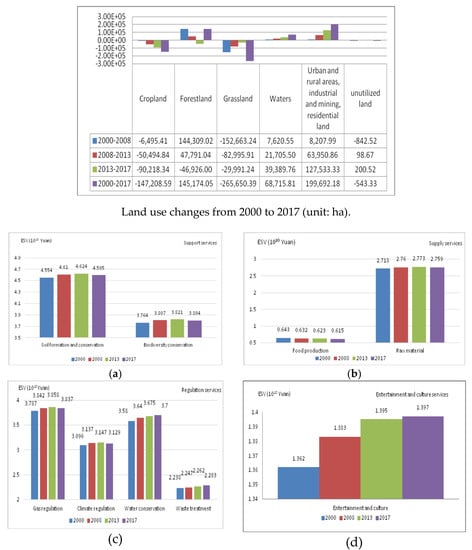Quantifying Land Use/Land Cover and Landscape Pattern Changes and Impacts on Ecosystem Services
Abstract
1. Introduction
2. Materials and Methods
2.1. Study Area
2.2. Methods
3. Results
3.1. Changes of Land Use and Land Cover
3.2. Landscape Pattern Indices at the Land Cover Type Level
3.3. Landscape Pattern Indices at the Landscape Level
3.4. ESVs
4. Discussion
4.1. Correlations between Landscape Patterns and Ecosystem Services
4.2. Impacts of Landscape Pattern Changes on Ecosystem Services
5. Conclusions
Supplementary Materials
Author Contributions
Funding
Conflicts of Interest
References
- Gemitzi, A.; Maria, A.; Venkat, L. “Vegetation Greening Trends In Different Land Use Types: Natural Variability Versus Human-induced Impacts In Greece”. Environ. Earth sci. 2019, 78, 172. [Google Scholar] [CrossRef]
- Turner, B.L., II; Skole, D.; Sanderson, S.; Fischer, G. Land use and land cover change science/research. In Plan IGBP Report No. 35 and HDP Report No. 7; International Institute for Applied Systems Analysis: Geneva, Switzerland, 1995. [Google Scholar]
- Lambin, E.F.; Baulies, X.; Bockstael, N. Land-use and land-cover change (LUCC). Implementation strategy: A core project of the International Geosphere-Biosphere Programme and the International Human Dimensions Programme on Global Environmental Change. Available online: Http://agris.fao.org/agris-search/search.do?recordID=SE2000022031 (accessed on 5 June 2019).
- Ellis, E.C.; Klein, G.K.; Siebert, S.; Lightman, D.; Ramankutty, N. Anthropogenic transformation of the biomes, 1700 to 2000. Global Ecol. Biogeogr. 2010, 19, 589–606. [Google Scholar] [CrossRef]
- Foley, J.A.; Ramankutty, N.; Brauman, K.A.; Cassidy, E.S.; Gerber, J.S.; Johnston, M.; Mueller, N.D.; O’Connell, C.; Ray, D.K.; West, P.C.; et al. Solutions for a cultivated planet. Nature 2011, 478, 337–342. [Google Scholar] [CrossRef] [PubMed]
- Kuemmerle, T.; Erb, K.; Meyfroidt, P.; Müller, D.; Verburg, P.H.; Estel, S.; Haberl, H.; Hostert, P.; Jepsen, M.R.; Kastner, T.; et al. Challenges and opportunities in mapping land use intensity globally. Curr. Opin. Env. Sust. 2013, 5, 1–10. [Google Scholar] [CrossRef] [PubMed]
- Nahuelhual, L.; Carmona, A.; Lozada, P.; Jaramillo, A.; Aguayo, M. Mapping recreation and ecotourism as a cultural ecosystem service: An application at the local level in Southern Chile. Appl. Geogr. 2013, 40, 71–82. [Google Scholar] [CrossRef]
- Balthazar, V.; Vanacker, V.; Molina, A.; Lambin, E.F. Impacts of forest cover change on ecosystem services in high Andean mountains. Ecol. Ind. 2015, 48, 63–75. [Google Scholar] [CrossRef]
- Hu, H.; Liu, W.; Cao, M. Impact of land use and land cover changes on ecosystem services in Menglun, Xishuangbanna, Southwest China. Environ. Monit. Assess. 2008, 146, 147–156. [Google Scholar] [CrossRef]
- Ian, J.B.; Georgina, M.M.; Carlo, F.; Giles, A.; Kerry, T. Economic analysis for ecosystem service assessments. Environ. Resour. Econ. 2011, 48, 177–218. [Google Scholar]
- Ouyang, Z.Y.; Zheng, H.; Xiao, Y.; Stephen, P.; Liu, J.G.; Xu, W.H.; Wang, Q.; Zhang, L.; Xiao, Y.; Rao, E.N.; et al. Gretchen Daily. Improvements in ecosystem services from investments in natural capital. Science 2016, 352, 1455–1459. [Google Scholar] [CrossRef]
- Christian, L. Measuring Nature’s Benefits: A Preliminary Roadmap for Improving Ecosystem Service Indicators; World Resource Institute: Washington, DC, USA, 2009. [Google Scholar]
- Zhao, Q.; Wen, Z.; Zhang, M. Identifying Forest Ecosystem Services Supplies and Demands—Insights from Ecosystem Services Flows. J. Forest Econ. 2014, 10, 3–7. [Google Scholar]
- Chai, J.; Wang, Z.; Zhang, H. Integrated Evaluation of Coupling Coordination for Land Use Change and Ecological Security: A Case Study in Wuhan City of Hubei Province, China. Int. J. Environ. Res. Public Health 2017, 14, 1435. [Google Scholar] [CrossRef] [PubMed]
- Wang, X.; Dong, X.; Liu, H.; Wei, H.; Fan, W.; Lu, N.; Xu, Z.; Ren, J.; Xing, K. Linking land use change, ecosystem services and human well-being: A case study of the Manas River Basin of Xinjiang, China. Ecosyst. Serv. 2017, 27, 113–123. [Google Scholar] [CrossRef]
- Baral, H.; Guariguata, M.R.; Keenan, R.J. A proposed framework for assessing ecosystem goods and services from planted forests. Ecosyst. Serv. 2016, 22, 260–268. [Google Scholar] [CrossRef]
- Liu, M.; Han, G.; Zhang, Q. Effects of Soil Aggregate Stability on Soil Organic Carbon and Nitrogen under Land Use Change in an Erodible Region in Southwest China. Int. J. Environ. Res. Public Health 2019, 16, 3809. [Google Scholar] [CrossRef]
- Godronm, F. Landscape Ecology; John Wiley and Sons: New York, NY, USA, 1986. [Google Scholar]
- Turner, G.; Gardner, R.H. Quantitative Methods in Landscape Ecology; Springer: New York, NY, USA, 1991. [Google Scholar]
- O’NeillR, V.; Krummel, J.R.; Gardner, R.H.; Sugihara, G.; Jackson, B.; DeAngelis, D.L.; Milne, B.T.; Turner, M.G.; Zygmunt, B.; Christensen, S.W.; et al. Indices of landscape pattern. J. Landsc. Ecol. 1998, 1, 153–162. [Google Scholar] [CrossRef]
- Haber, W. Landscape ecology as a bridge from ecosystems to human ecology. Ecol. Res. 2004, 19, 99–106. [Google Scholar] [CrossRef]
- Vigl, L.E.; Schirpke, U.; Tasser, E.; Tappeiner, U. Linking long-term landscape dynamics to the multiple interactions among ecosystem services in the European Alps. J. Landsc. Ecol. 2016, 31, 1903–1918. [Google Scholar] [CrossRef]
- Fu, B.; Liang, D.; Lu, N. Landscape ecology: Coupling of pattern, process, and scale. J. Chin. Geogr. Sci. 2011, 21, 385–391. [Google Scholar] [CrossRef]
- Corry, R.C. Characterizing Fine-scale Patterns of Alternative Agricultural Landscapes with Landscape Pattern Indices. Landsc. Ecol. 2005, 20, 591–608. [Google Scholar] [CrossRef]
- Riitters, K.H.; O’Neill, R.V.; Hunsaker, C.T.; Wickham, J.D.; Yankee, D.H.; Timmins, S.P.; Jones, K.B.; Jackson, B.L. A factor analysis of landscape pattern and structure metrics. Landsc. Ecol. 1995, 10, 23–39. [Google Scholar] [CrossRef]
- Gunilla, A.E. Landscape change patterns in mountains, land use and enviornmental diversity. Landsc. Ecol. 2000, 15, 155–170. [Google Scholar]
- Wu, J. Effects of changing scale on landscape pattern analysis: Scaling relations. J. Landsc. Ecol. 2004, 19, 125–138. [Google Scholar] [CrossRef]
- Palang, H.; Mander, U.; Luud, A. Landscape diversity changes in Estonia. Landscape Urban Plan. 1998, 41, 163–169. [Google Scholar] [CrossRef]
- Michael, T. Applying ecological models to altered landscapes Scenario-testing with GIS. Landscape Urban Plan. 1998, 41, 3–18. [Google Scholar]
- Jerry, A.G.; Esward, A.M.; Kevin, P.P. Landscape structure analysis of Kansas at three scales. Landscape Urban Plan. 2000, 52, 45–61. [Google Scholar]
- Marc, A. Landscape change and urbanization process in Europe. Landscape Urban Plan. 2004, 57, 9–26. [Google Scholar]
- Elke, H.; Rainer, W.; Annette, O. Analysing land-cover changes in relation to environmental variables in Hesse, Germany. Landsc. Ecol. 2004, 19, 473–489. [Google Scholar]
- Tony, P. Modeling ecological impacts of landscape change. Environ. Model. Softw. 2006, 20, 1359–1363. [Google Scholar]
- Gardner, R.H.; Milne, B.T.; Turnei, M.G.; O’Neill, R.V. Neutral Models for the Analysis of Broad-Scale Landscape Pattern. Landsc. Ecol. 1987, 1, 19–28. [Google Scholar] [CrossRef]
- Haines-Young, R.; Chopping, M. Quantifying landscape structure: A review of landscape indices and their application to forested landscape. Prog. Phys. Geogr. 1996, 20, 418–445. [Google Scholar] [CrossRef]
- O’Neill, R.V.; Riitters, K.H.; Wickham, J.D.; Jones, K.B. Landscape pattern metrics and regional assessment. Ecosyst. Health 1999, 5, 225–233. [Google Scholar] [CrossRef]
- Luck, M.; Wu, J. A gradient analysis of urban landscape pattern: A case study from the Phoenix metropolitan region, Arizona, USA. Landsc. Ecol. 2002, 17, 327–339. [Google Scholar] [CrossRef]
- Liu, X.; Zhang, Y.; Dong, G.; Hou, G.; Jiang, M. Landscape Pattern Changes in the Xingkai Lake Area, Northeast China. Int. J. Environ. Res. Public Health 2019, 16, 3820. [Google Scholar] [CrossRef] [PubMed]
- Burkhard, B.; Kroll, F.; Muller, F.; Windhorst, W. Landscapes’ Capacities to Provide Ecosystem Services—A Concept for Land-Cover Based Assessments. J. Landsc. Online 2009, 15, 1–22. [Google Scholar] [CrossRef]
- Ma, L.; Bo, J.; Li, X.; Fang, F.; Cheng, W. Identifying key landscape pattern indices influencing the ecological security of inland river basin: The middle and lower reaches of Shule River Basin as an example. J. Sci. Total. Environ. 2019, 674, 424–438. [Google Scholar] [CrossRef]
- Varga, D.; Roigé, M.; Pintó, J.; Saez, M. Assessing the Spatial Distribution of Biodiversity in a Changing Temperature Pattern: The Case of Catalonia, Spain. Int. J. Environ. Res. Public Health 2019, 16, 4026. [Google Scholar] [CrossRef]
- Han, H.; Dong, Y. Assessing and mapping of multiple ecosystem services in Guizhou Province, China. Trop. Ecol. 2017, 58, 331–346. [Google Scholar]
- Buckerfield, S.; Waldron, S.; Quilliam, R.; Naylor, L.; Li, S.; Oliver, D. How can we improve understanding of faecal indicator dynamics in karst systems under changing climatic, population, and land use stressors? -Research opportunities in SW China. Sci. Total Environ. 2019, 646, 438–447. [Google Scholar] [CrossRef]
- Zhang, D.; Min, Q.; Liu, M.; Cheng, S. Ecosystem service tradeoff between traditional and modern agriculture: A case study in Congjiang County, Guizhou Province, China. Front. Env. Sci. Eng. 2012, 6, 743–752. [Google Scholar] [CrossRef]
- Estoque, R.C.; Murayama, Y. Quantifying landscape pattern and ecosystem service value changes in four rapidly urbanizing hill stations of Southeast Asia. Landsc. Ecol. 2016, 31, 1481–1507. [Google Scholar] [CrossRef]
- Jiang, Z.; Lian, Y.; Qin, X. Rocky Desertification in Southwest China: Impacts, Causes, and Restoration. J. Earth-Sci. Rev. 2014, 132, 1–12. [Google Scholar] [CrossRef]
- Huang, B.Q.; Huang, J.L.; Robert, G.P.J.; Tu, Z.S. Comparison of Intensity Analysis and the land use dynamic degrees to measure land changes outside versus inside the coastal zone of Longhai, China. Ecol. Indic. 2018, 89, 336–347. [Google Scholar] [CrossRef]
- Schumaker, N.H. Using Landscape Indices to Predict Habitat Connectivity. J. Ecol. 1996, 77, 1210–1225. [Google Scholar] [CrossRef]
- Li, H.B.; Wu, J.G. Use and misuse of landscape indices. J. Landsc. Ecol. 2004, 19, 389–399. [Google Scholar] [CrossRef]
- Tischendorf, L. Can landscape indices predict ecological processes consistently? J. Landsc. Ecol. 2001, 16, 235–254. [Google Scholar] [CrossRef]
- McGarigal, K.; Cushman, S.A.; Ene, E. FRAGSTATS v4: Spatial Pattern Analysis Program for Categorical and Continuous Maps. Available online: http://www.umass.edu/landeco/research/fragstats/fragstats.html (accessed on 10 May 2019).
- Egarter, V.L.; Tasser, E.; Schirpke, U.; Tappeiner, U. Using land use/land cover trajectories to uncover ecosystem service patterns across the Alps. J. Reg. Environ. Change 2017, 17, 2237–2250. [Google Scholar] [CrossRef]
- Brink, P.T. Estimating the Overall Economic Value of the Benefits Provided by the Natura 2000 Network; Institute for European Environmental Policy: London, UK, 2011. [Google Scholar]
- Li, F.; Zhang, S.W.; Yang, J.C.; Chang, L.P.; Yang, H.J.; Bu, K. Effects of land use change on ecosystem services value in West Jilin since the reform and opening of China. Ecosys. Serv. 2018, 31, 12–20. [Google Scholar]
- Costanza, R.; D"Arge, R.; De Groot, R.; Farber, S.; Grasso, M.; Hannon, B.; Limburg, K.E.; Naeem, S.; Oneill, R.V.; Paruelo, J.M.; et al. The value of the world’s ecosystem services and natural capital. Glob. Environ. 1997, 387, 253–260. [Google Scholar] [CrossRef]
- Xie, G.D.; Zhen, L.; Lu, C.X.; Xiao, Y.; Chen, C. Expert knowledge based valuation method of ecosystem services in China. J. Natur. Resour. 2008, 23, 911–919. [Google Scholar]
- Yu, Z.; Qin, T.; Yan, D.; Yang, M.; Yu, H.; Shi, W. The Impact on the Ecosystem Services Value of the Ecological Shelter Zone Reconstruction in the Upper Reaches Basin of the Yangtze River in China. Int. J. Environ. Res. Public Health 2018, 15, 2273. [Google Scholar] [CrossRef]
- Liu, Y.; Li, J.C.; Yang, Y.G. Evaluation of forest ecosystem services based on biomass in Shanxi Province. Acta Ecol. Sin. 2012, 32, 2699–2706. [Google Scholar]
- Li, J.; Bluemling, B.; Dries, L. Property Rights Effects on Farmers’ Management Investment in Forestry Projects: The Case of Camellia in Jiangxi, China. Small-Scale For. 2016, 15, 271–289. [Google Scholar] [CrossRef]
- Wen, B.; Pan, Y.; Zhang, Y.; Liu, J.; Xia, M. Does the Exhaustion of Resources Drive Land Use Changes? Evidence from the Influence of Coal Resources-Exhaustion on Coal Resources-Based Industry Land Use Changes. Sustainability 2018, 10, 2698. [Google Scholar] [CrossRef]
- Ning, Z.; Sun, C. Forest management with wildfire risk, prescribed burning and diverse carbon policies. Forest Policy Econ. 2017, 75, 95–102. [Google Scholar] [CrossRef]
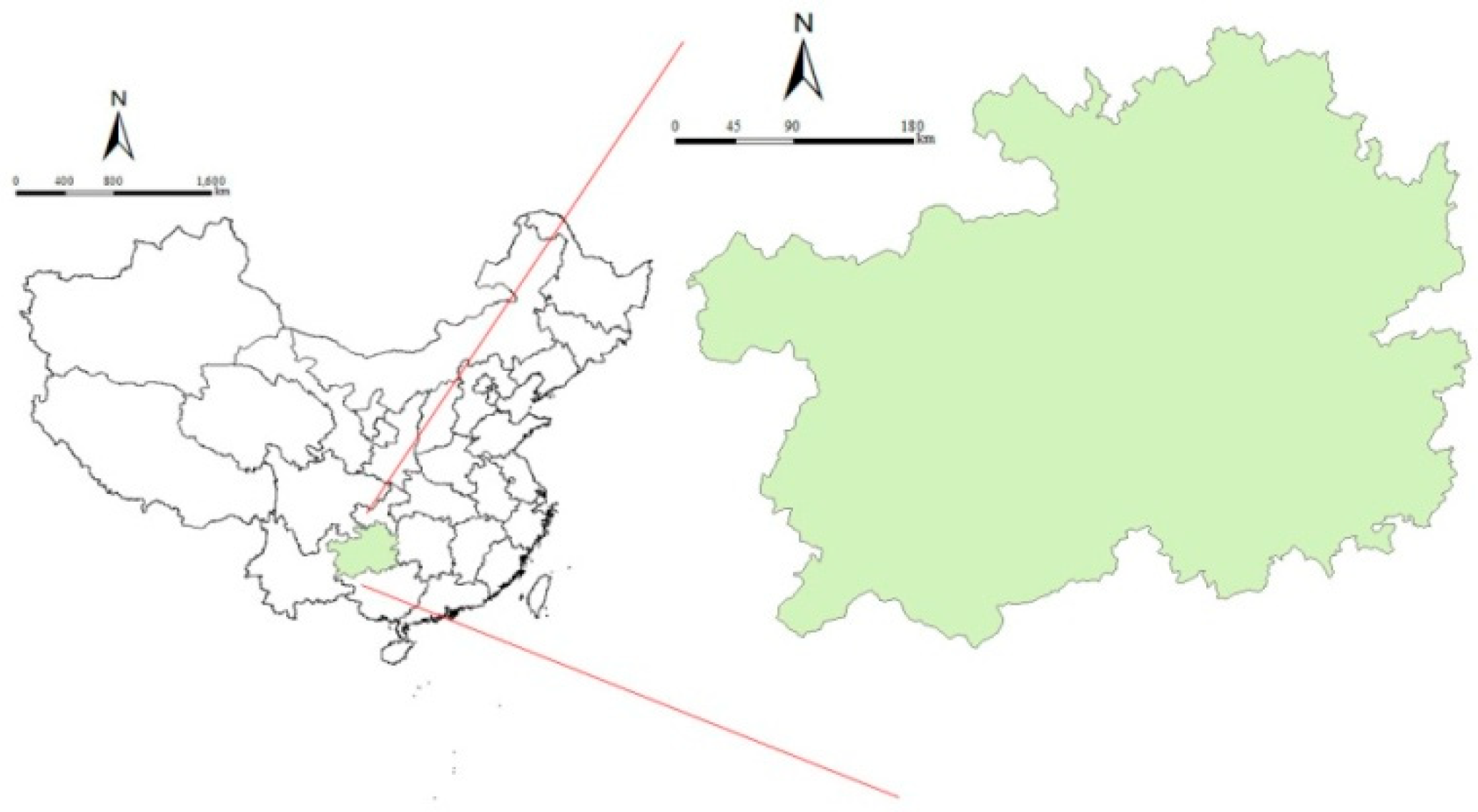
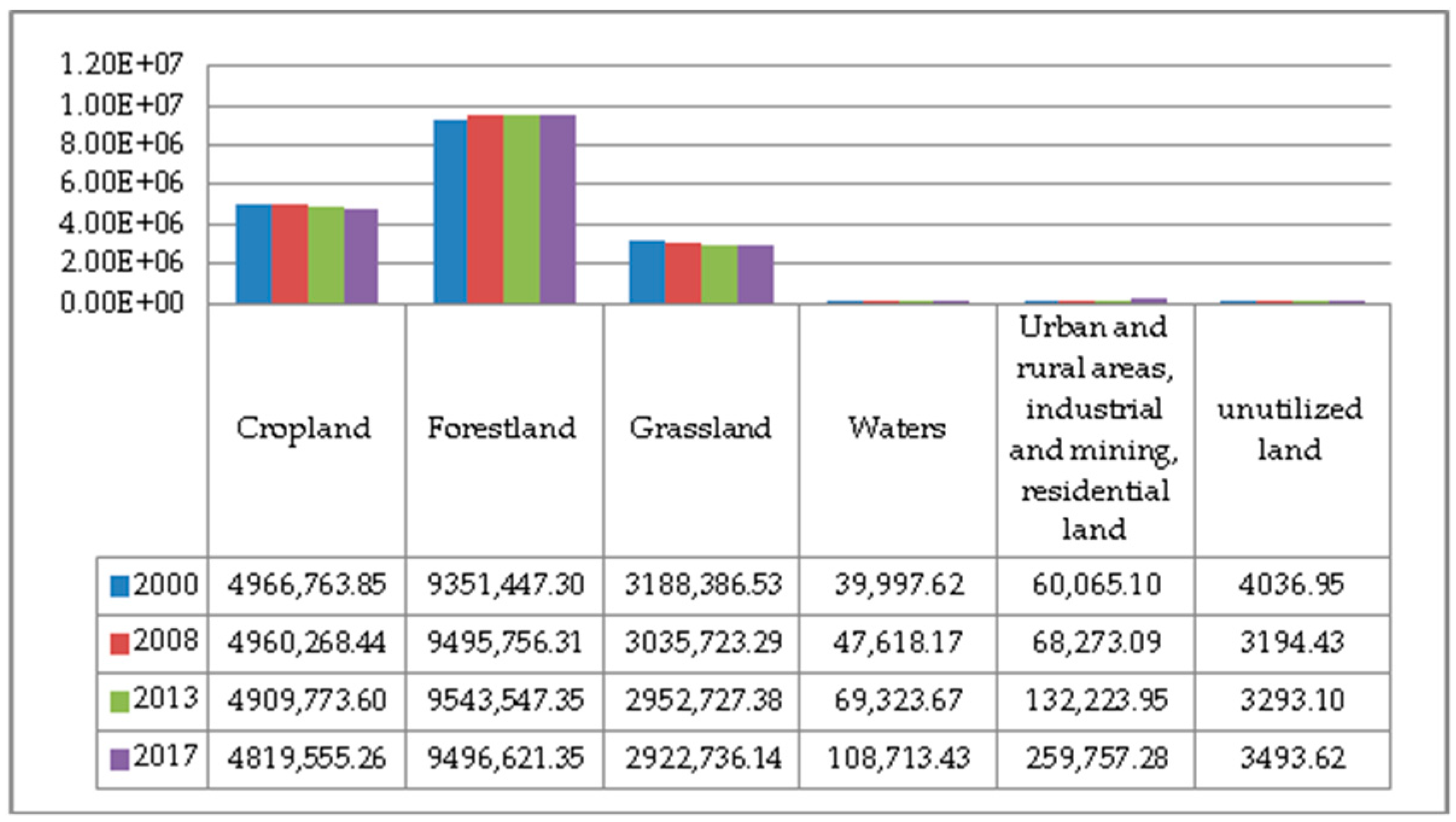

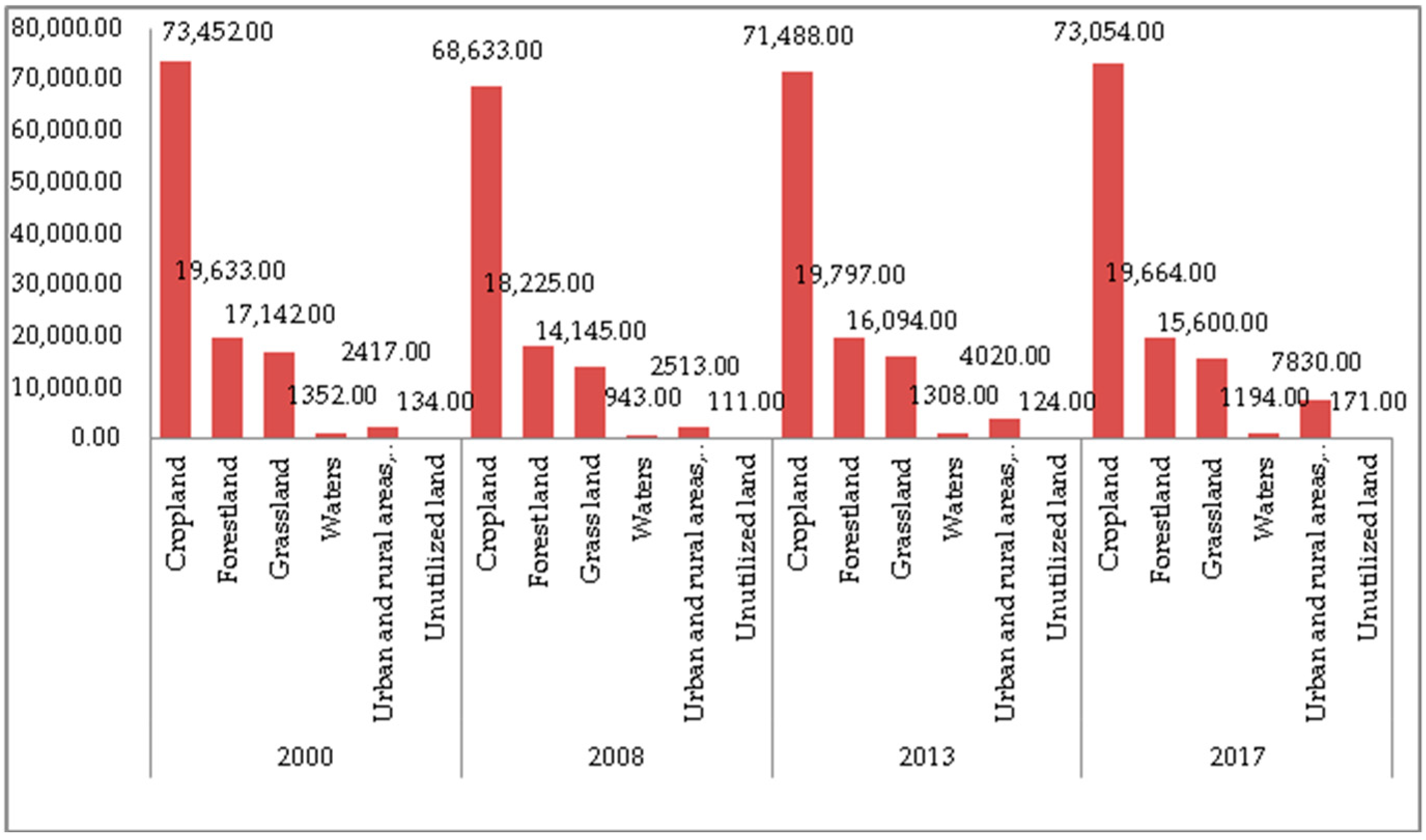
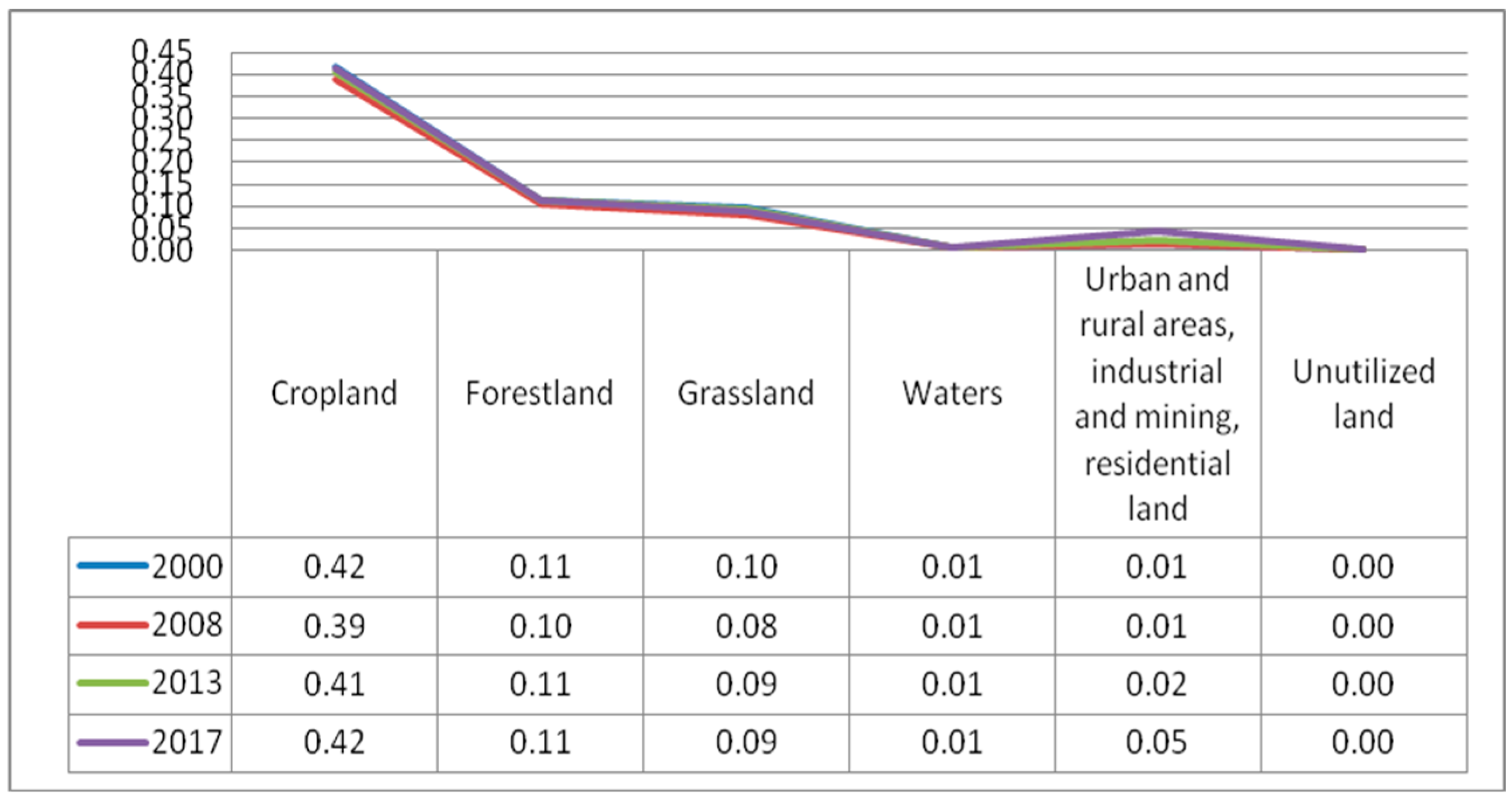
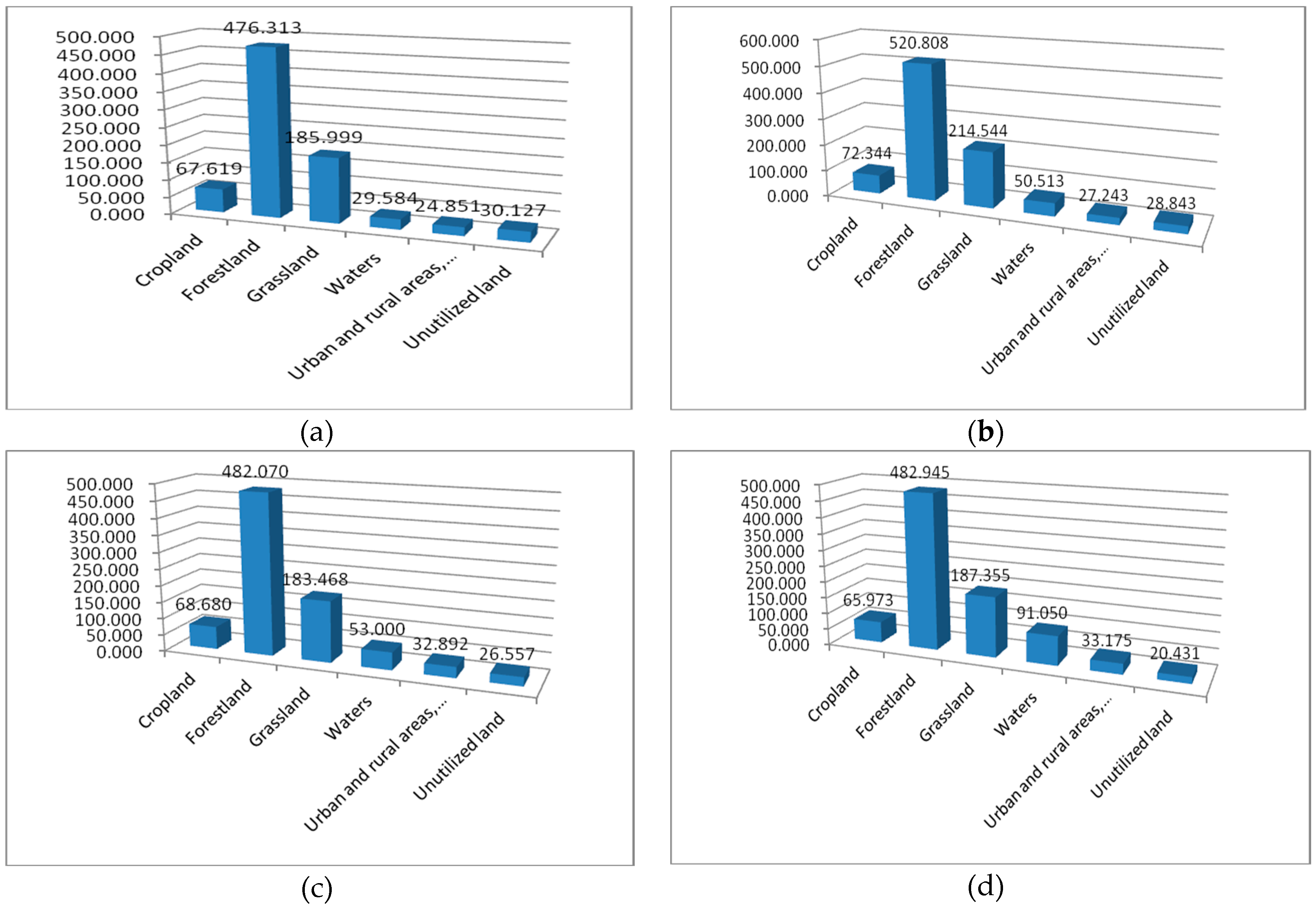
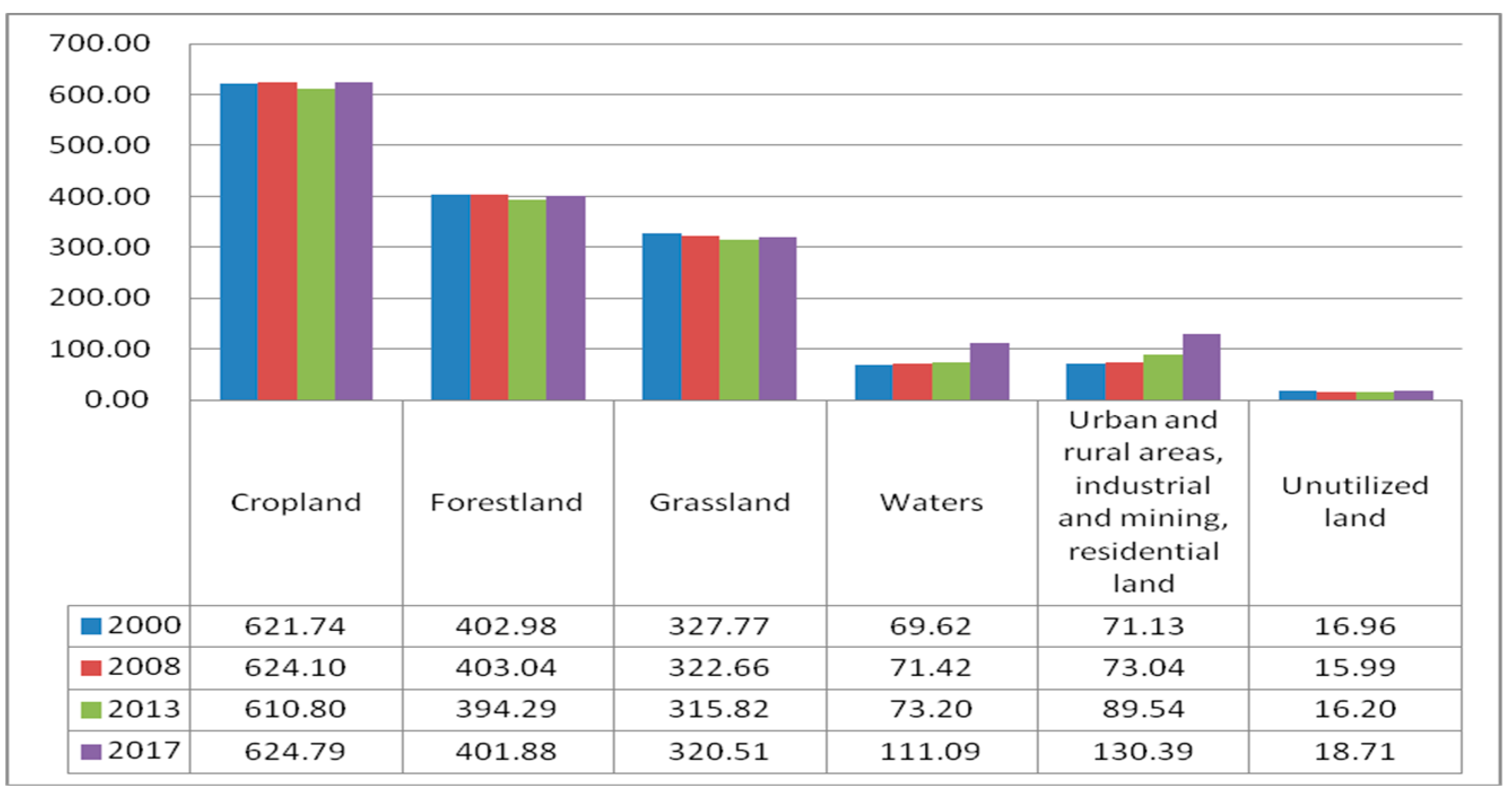
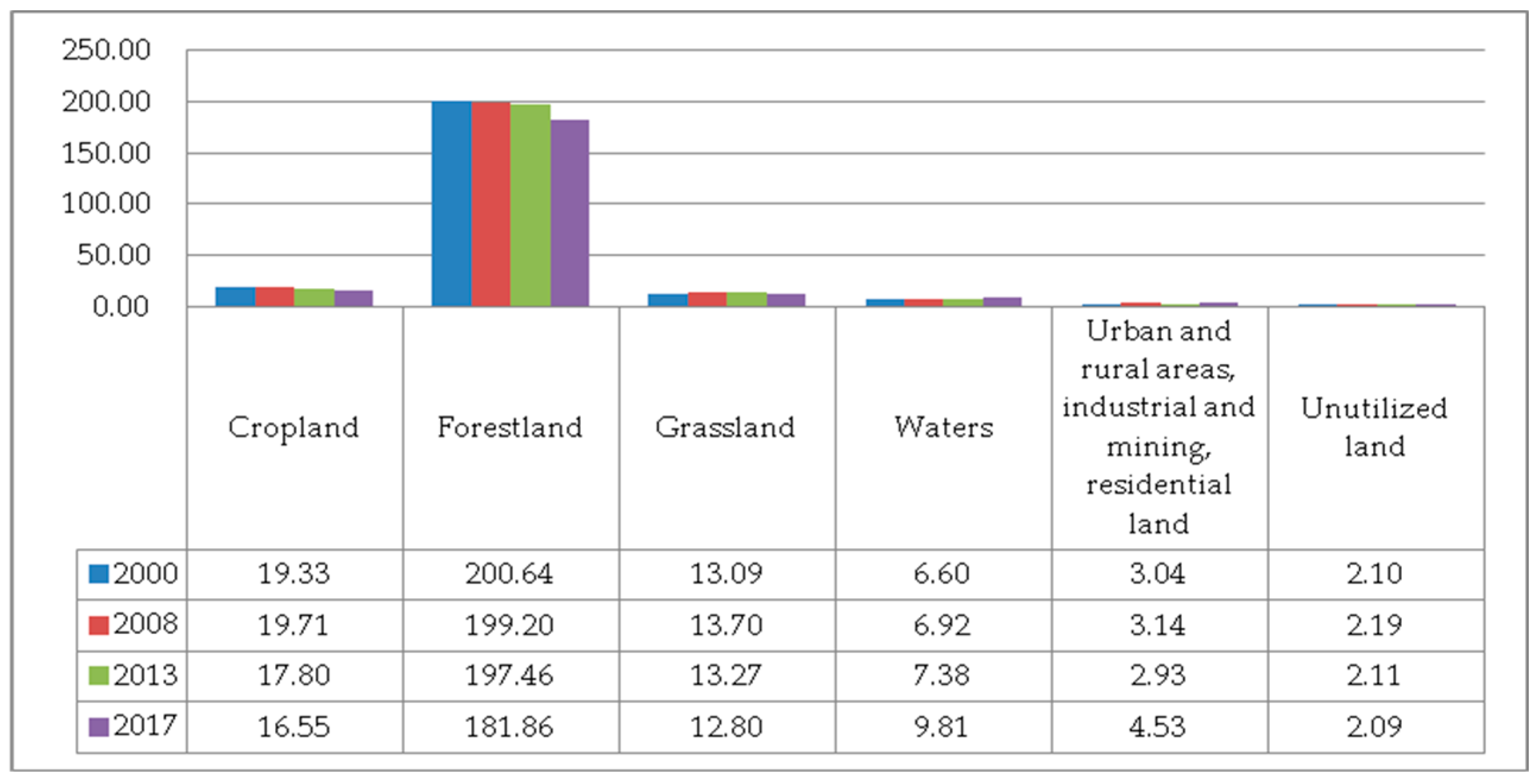
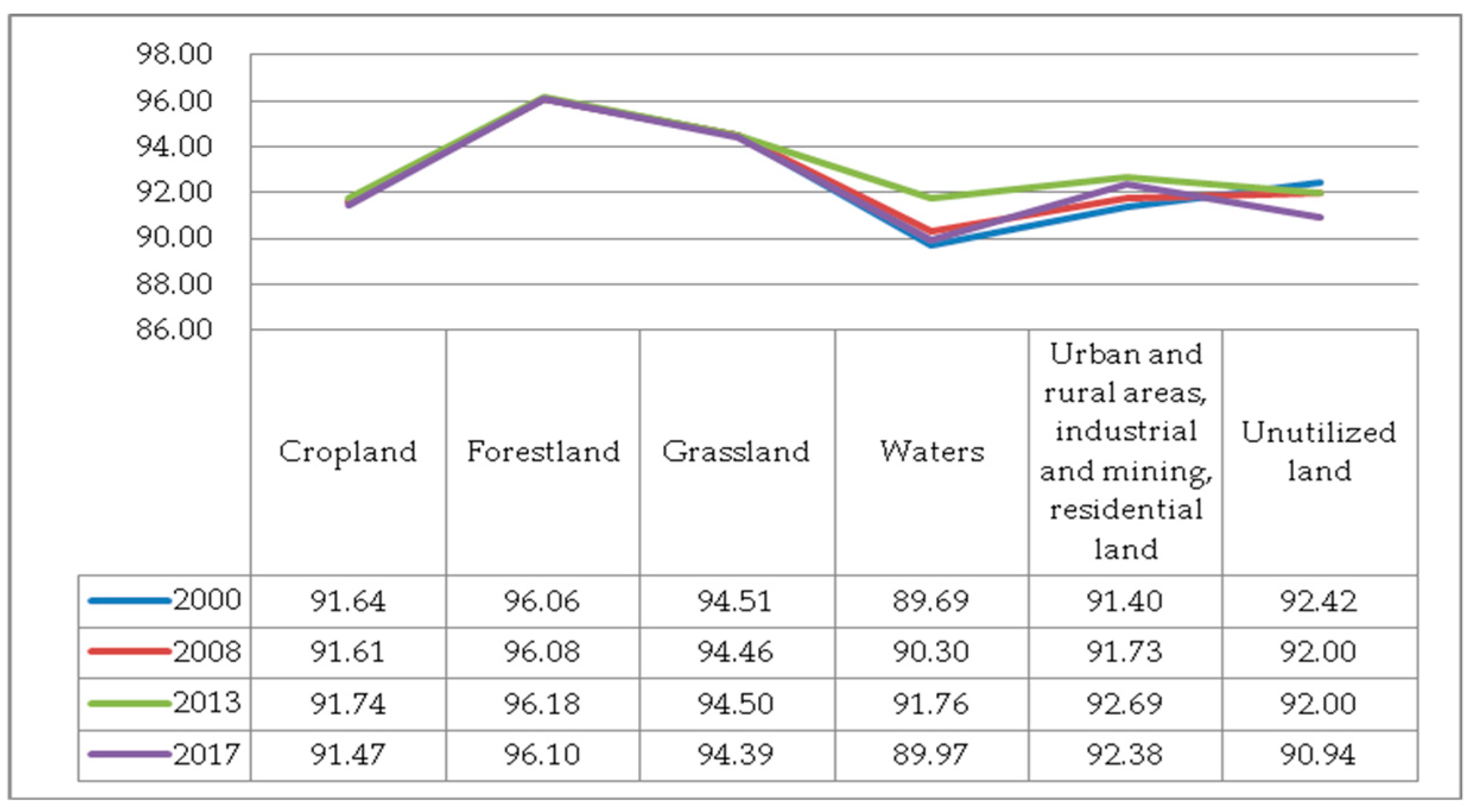
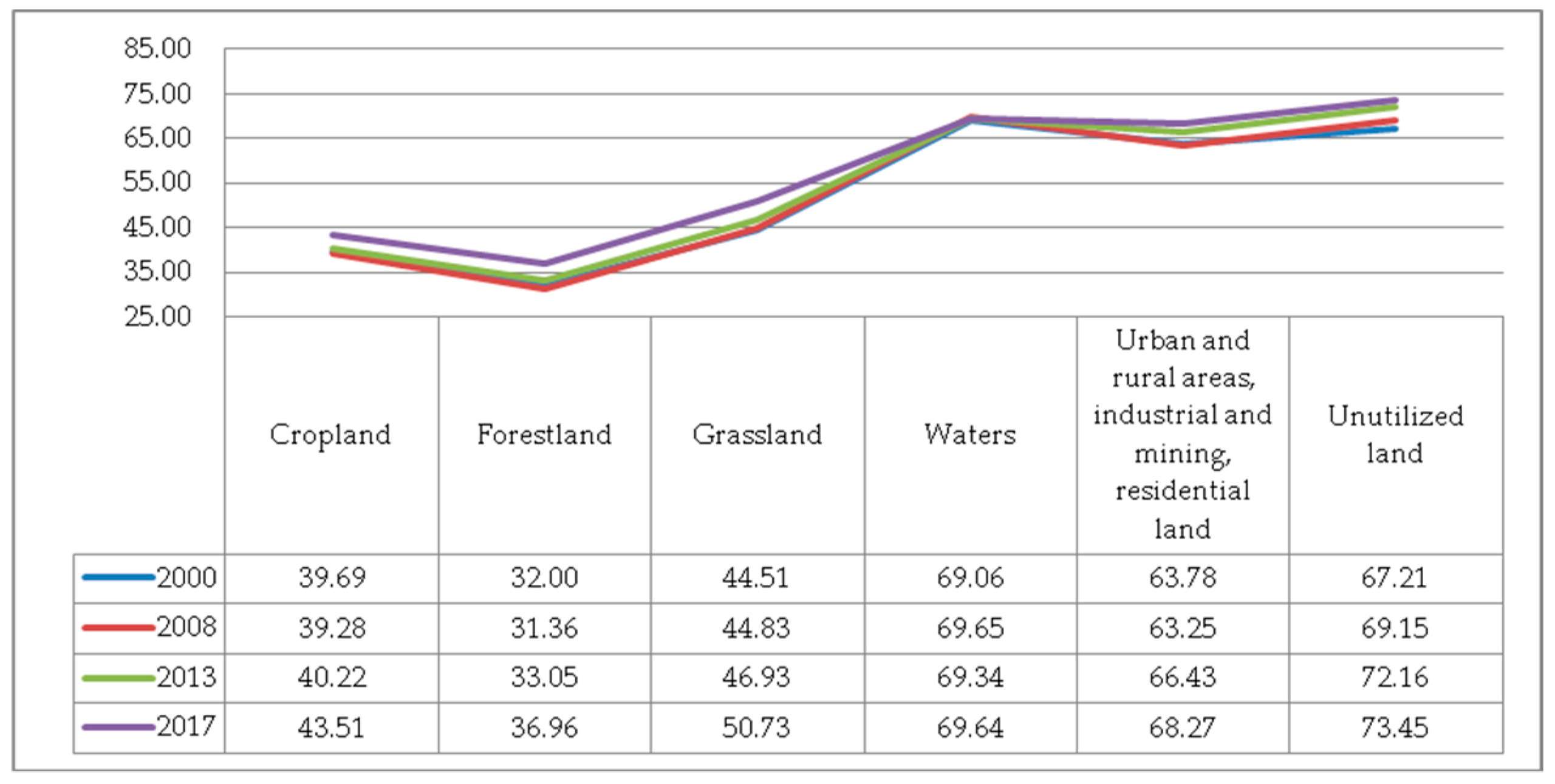
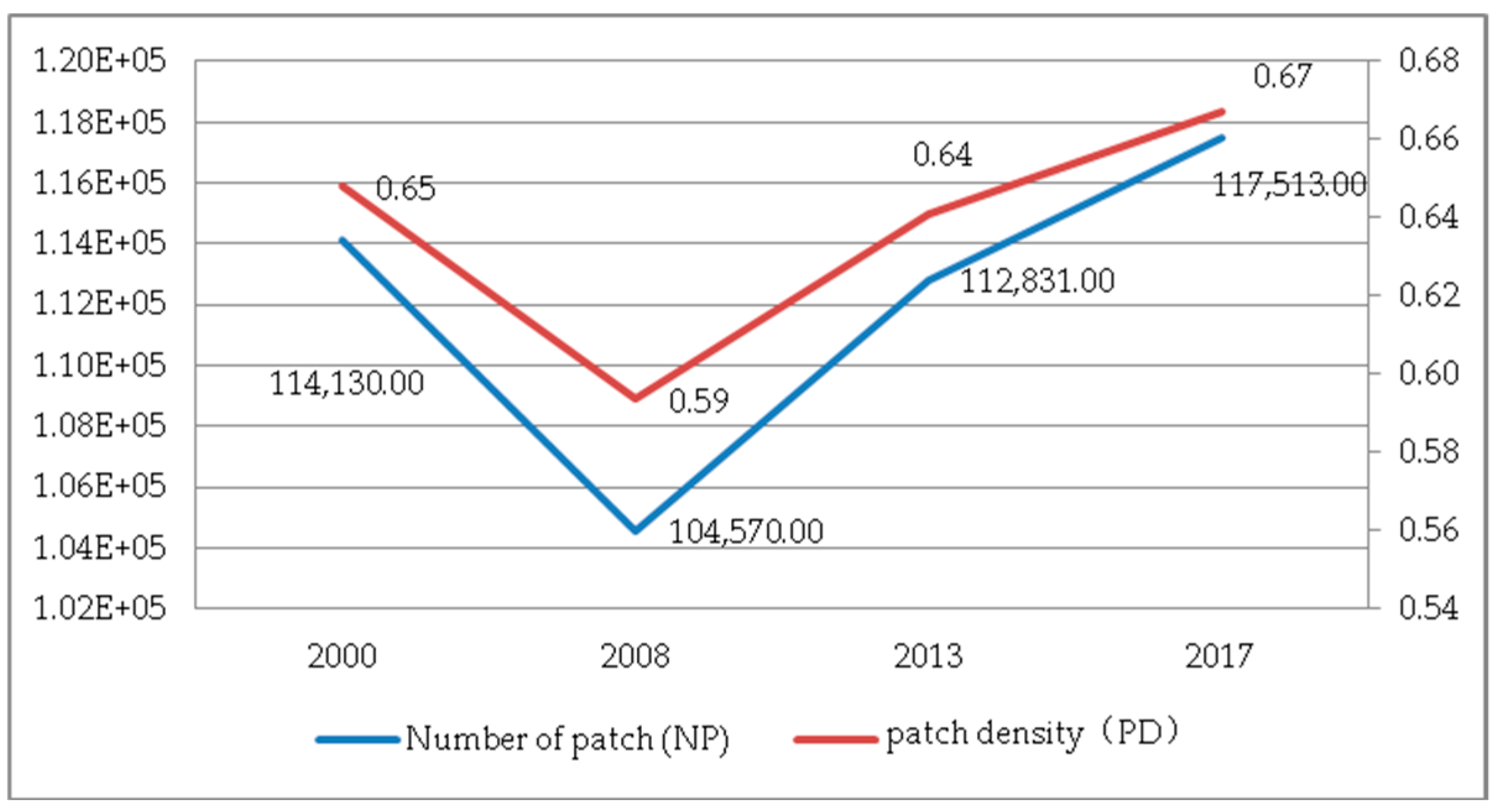
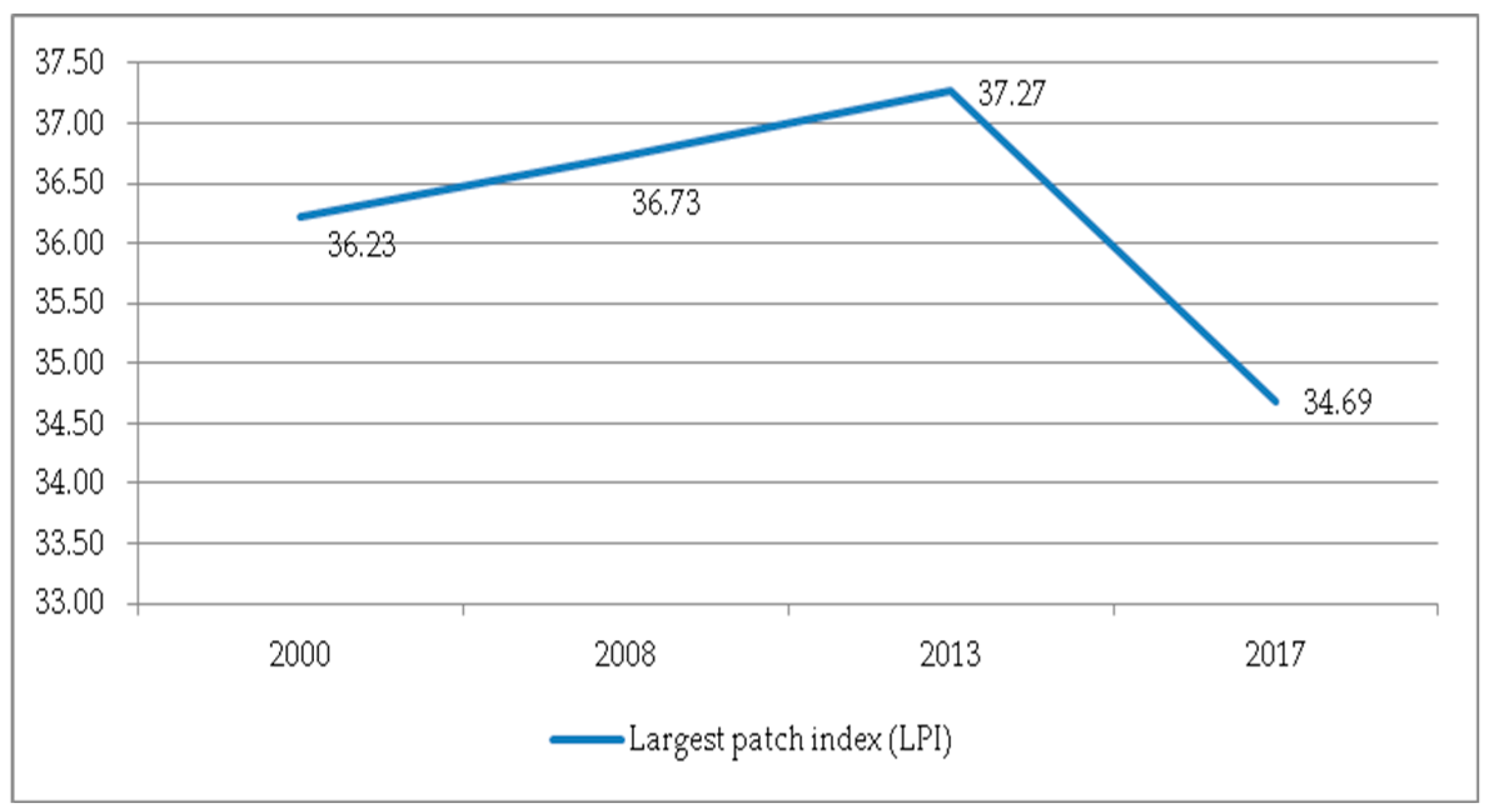
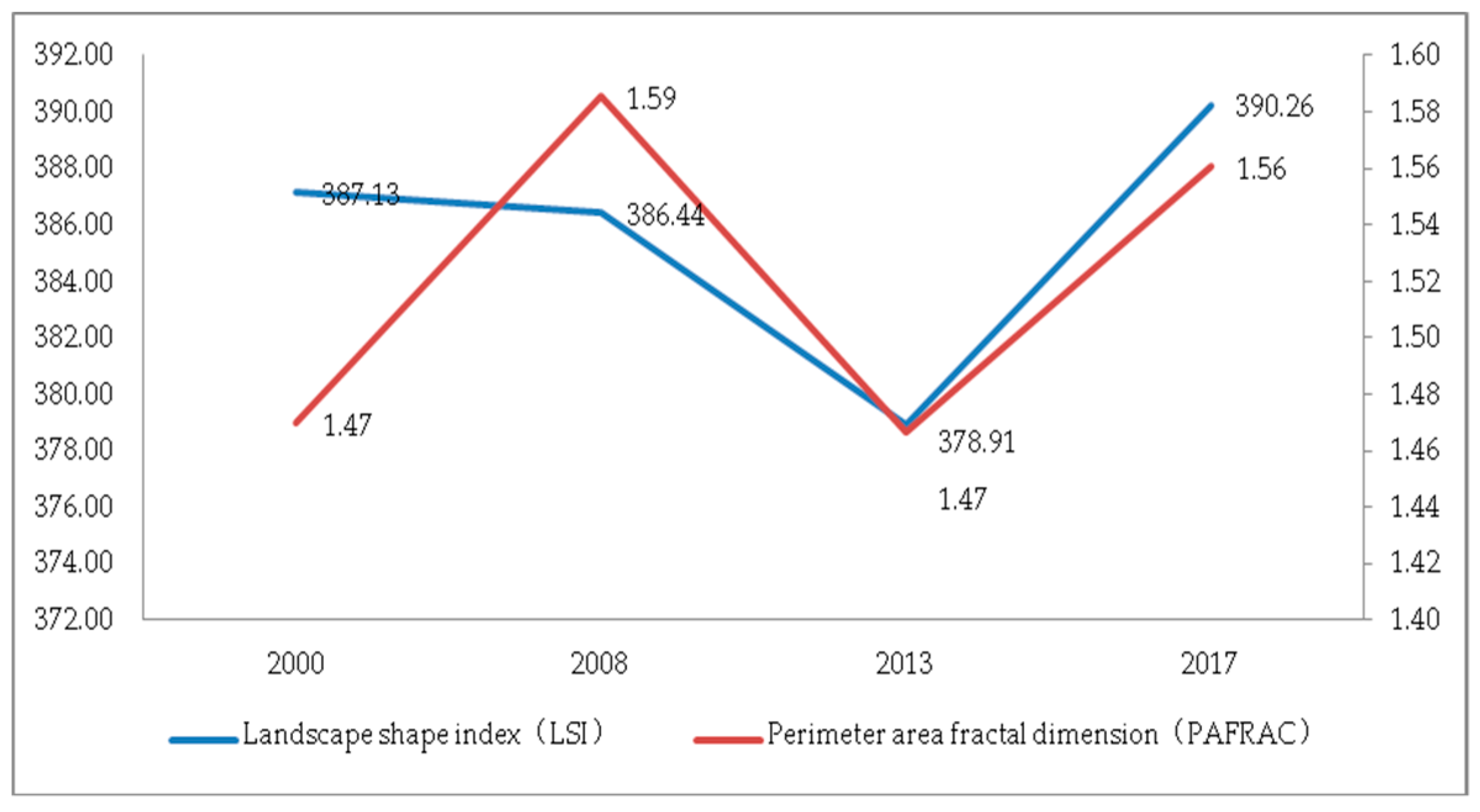

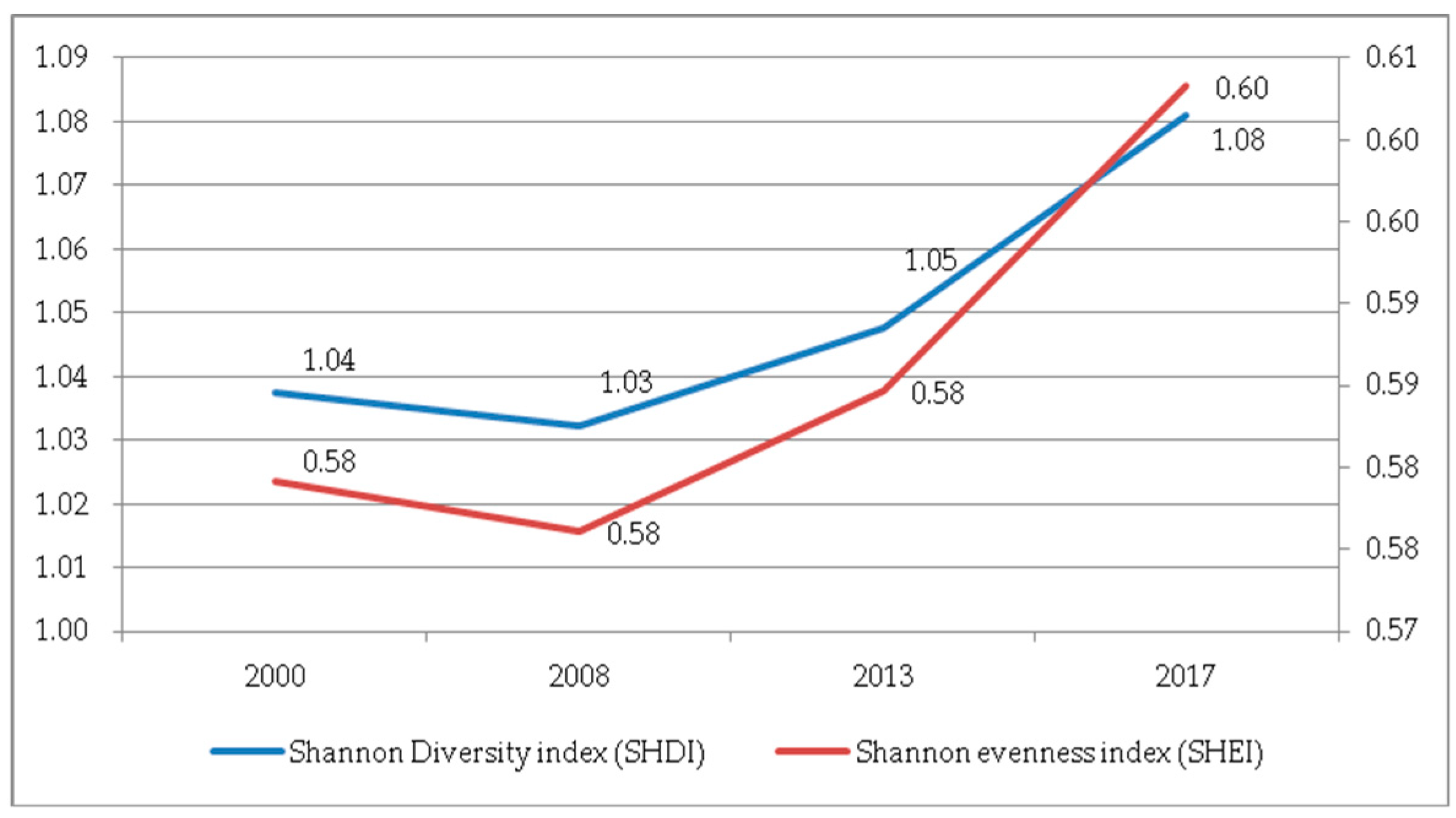
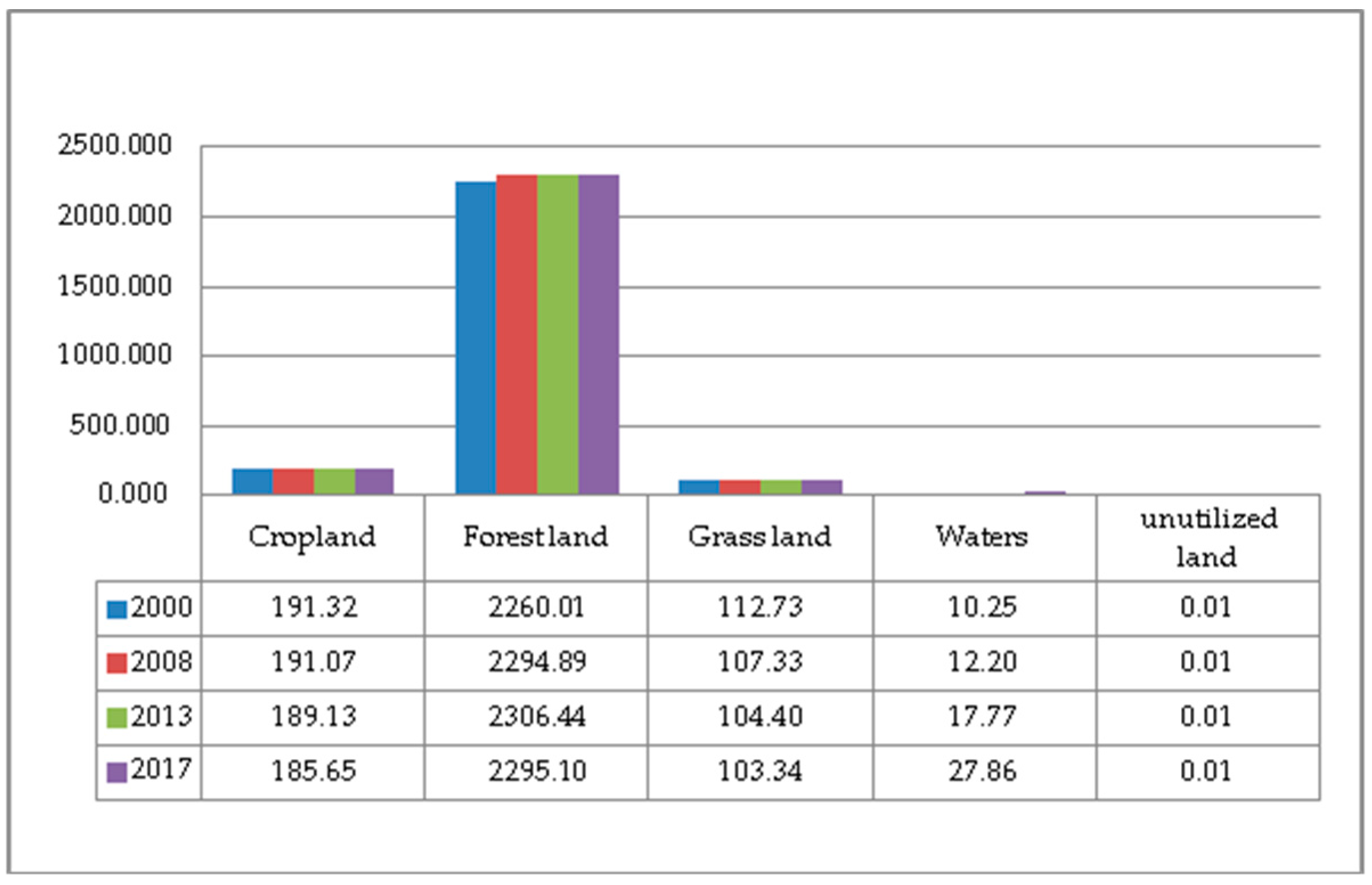
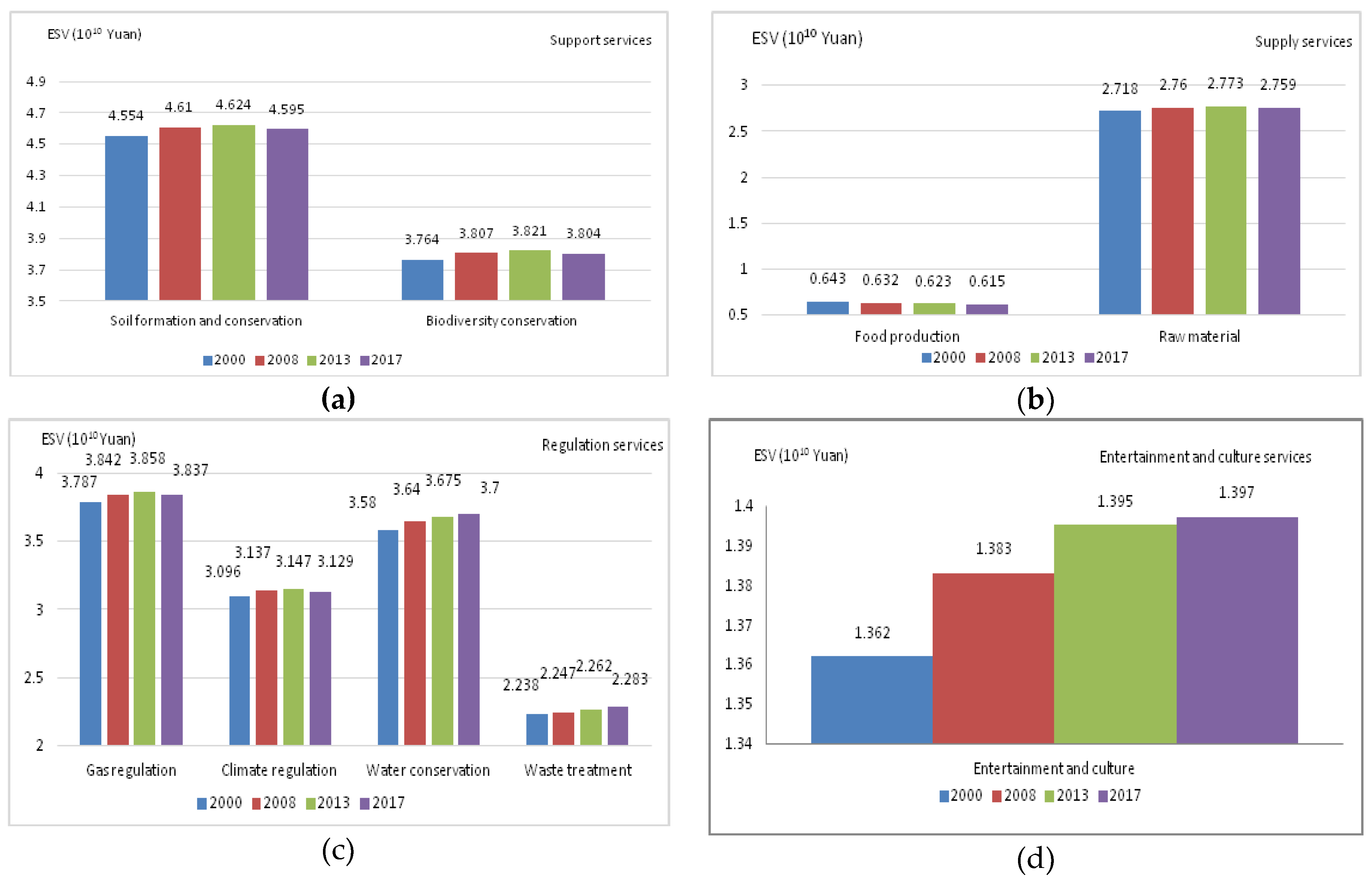
| Ecosystem Service Type | Land Use Type | ||||
|---|---|---|---|---|---|
| Cropland | Forestland | Grassland | Water Bodies | Unutilized Land | |
| Gas regulation | 278.71 | 3871.25 | 90.34 | 0.00 | 0.00 |
| Climate regulation | 496.13 | 2986.38 | 176.31 | 256.41 | 0.00 |
| Water conservation | 334.47 | 3539.38 | 184.41 | 11,360.92 | 16.70 |
| Soil formation and protection | 813.90 | 4313.63 | 363.83 | 5.54 | 11.15 |
| Waste treatment | 914.26 | 1449.00 | 1217.97 | 10,134.56 | 5.54 |
| Biodiversity conservation | 395.77 | 3605.75 | 594.43 | 1388.08 | 189.50 |
| Food production | 557.49 | 110.63 | 822.98 | 55.76 | 5.54 |
| Raw material | 55.76 | 2875.75 | 4.36 | 5.54 | 0.00 |
| Entertainment and culture | 5.54 | 1415.75 | 80.99 | 2419.33 | 5.54 |
| Total | 3852.01 | 24,167.50 | 3535.62 | 25,626.13 | 233.98 |
| 2000 | 2017 | ||||||
|---|---|---|---|---|---|---|---|
| Cropland | Forest land | Grassland | Water bodies | Urban and rural, industrial and mining, and residential land | Unutilized land | Total ESV | |
| Cropland | / | 5273.077 | −25.645 | 511.286 | −480.742 | −0.619 | 5277.357 |
| Forestland | −4452.025 | / | −1441.382 | 47.283 | −1009.41 | −9.619 | −6865.153 |
| Grassland | 37.757 | 5075.562 | / | 332.465 | −132.785 | −0.812 | 5312.187 |
| Water bodies | −19.075 | −1.601 | −13.586 | / | −5.679 | −0.037 | −39.978 |
| Urban and rural, industrial and mining, and residential land | 8.956 | 28.185 | 3.007 | 12.225 | / | 0 | 52.373 |
| Unutilized land | 0.573 | 18.97 | 0.781 | 0.518 | −0.036 | / | 20.806 |
| Total ESV | −4423.814 | 10,394.193 | −1476.825 | 903.777 | −1628.652 | −11.087 | 3757.592 |
| Value Factor Vk | 2000 | 2008 | 2013 | 2017 | ||||
|---|---|---|---|---|---|---|---|---|
| ESV Percentage | CS | ESV Percentage | CS | ESV Percentage | CS | ESV Percentage | CS | |
| Cropland Vk ± 50% | 3.716 | 0.074 | 3.667 | 0.073 | 3.612 | 0.072 | 3.554 | 0.071 |
| Forestland Vk ± 50% | 43.895 | 0.878 | 44.039 | 0.881 | 44.054 | 0.881 | 43.935 | 0.879 |
| GrasslandVk ± 50% | 2.189 | 0.044 | 2.060 | 0.041 | 1.994 | 0.040 | 1.978 | 0.040 |
| Water bodies Vk ± 50% | 0.199 | 0.004 | 0.234 | 0.005 | 0.339 | 0.007 | 0.533 | 0.011 |
| Unutilized land Vk ± 50% | 0.000 | 0 | 0.000 | 0 | 0.000 | 0 | 0.000 | 0 |
| Landscape Index | NP | LSI | AREA_MN | SHAPE_AM | IJI | AI |
|---|---|---|---|---|---|---|
| Correlation coefficient | 0.028 | 0.329 | 0.948 ** | 0.999 ** | −0.671 ** | 0.769 ** |
© 2019 by the authors. Licensee MDPI, Basel, Switzerland. This article is an open access article distributed under the terms and conditions of the Creative Commons Attribution (CC BY) license (http://creativecommons.org/licenses/by/4.0/).
Share and Cite
Zhao, Q.; Wen, Z.; Chen, S.; Ding, S.; Zhang, M. Quantifying Land Use/Land Cover and Landscape Pattern Changes and Impacts on Ecosystem Services. Int. J. Environ. Res. Public Health 2020, 17, 126. https://doi.org/10.3390/ijerph17010126
Zhao Q, Wen Z, Chen S, Ding S, Zhang M. Quantifying Land Use/Land Cover and Landscape Pattern Changes and Impacts on Ecosystem Services. International Journal of Environmental Research and Public Health. 2020; 17(1):126. https://doi.org/10.3390/ijerph17010126
Chicago/Turabian StyleZhao, Qingjian, Zuomin Wen, Shulin Chen, Sheng Ding, and Minxin Zhang. 2020. "Quantifying Land Use/Land Cover and Landscape Pattern Changes and Impacts on Ecosystem Services" International Journal of Environmental Research and Public Health 17, no. 1: 126. https://doi.org/10.3390/ijerph17010126
APA StyleZhao, Q., Wen, Z., Chen, S., Ding, S., & Zhang, M. (2020). Quantifying Land Use/Land Cover and Landscape Pattern Changes and Impacts on Ecosystem Services. International Journal of Environmental Research and Public Health, 17(1), 126. https://doi.org/10.3390/ijerph17010126





